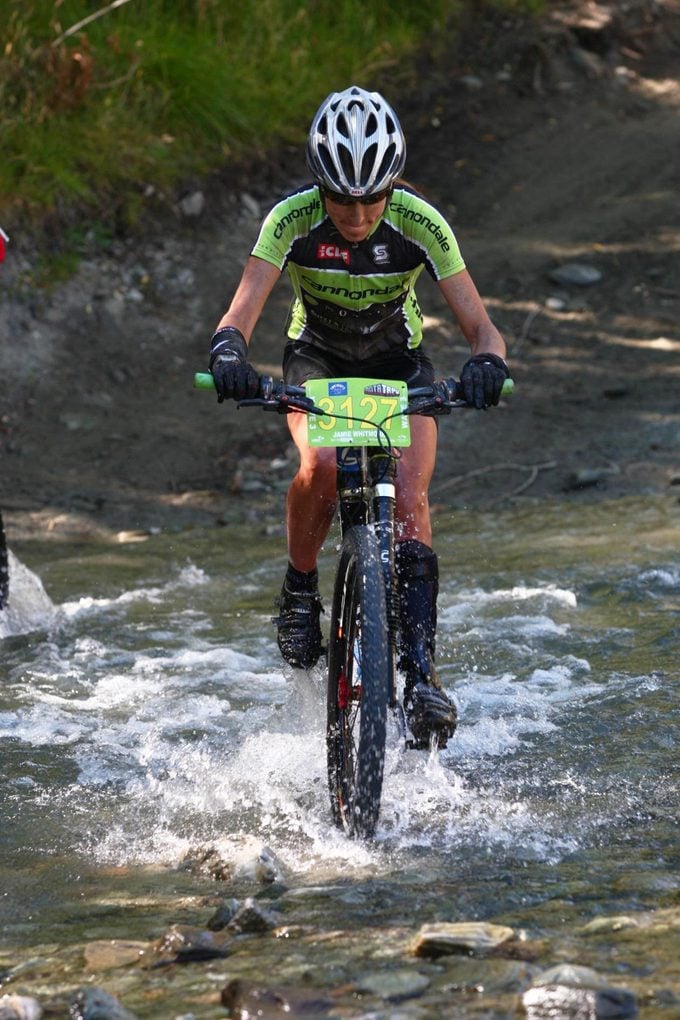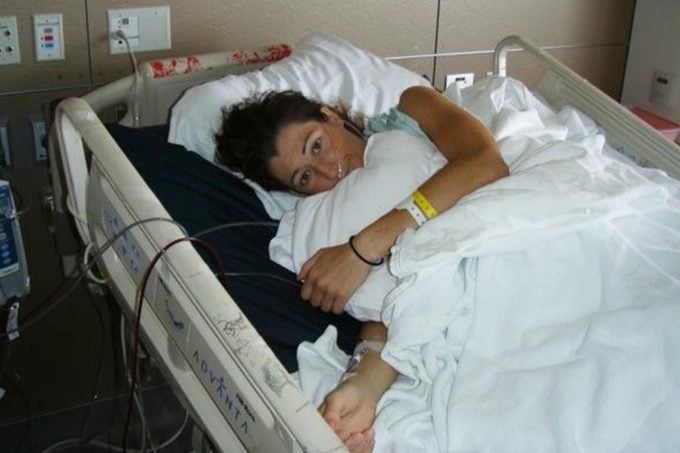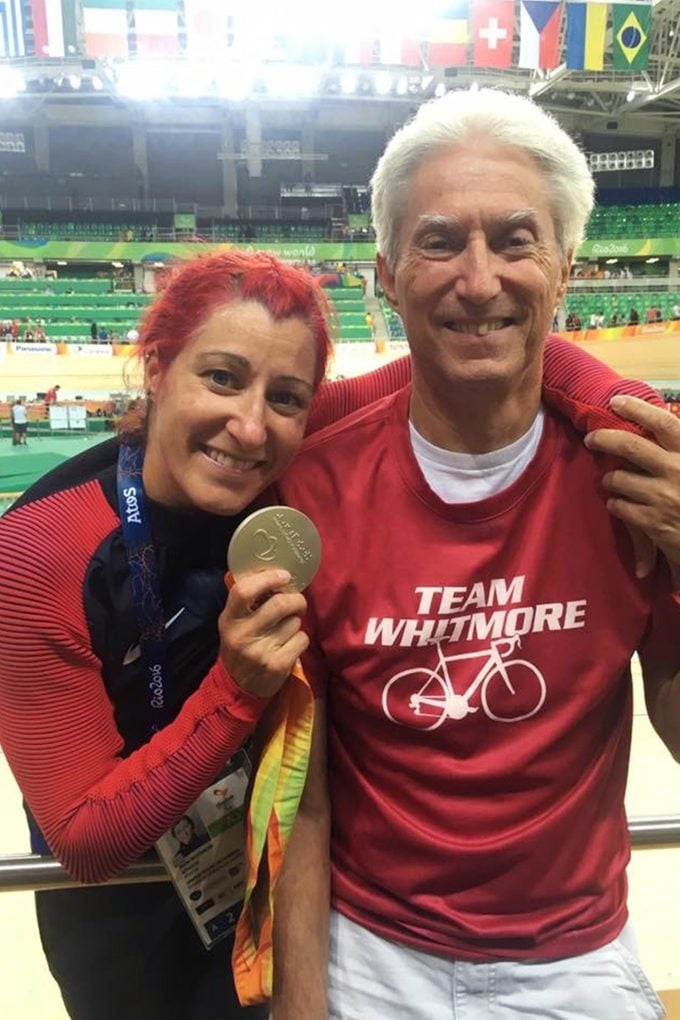One Woman’s Unbearable Leg Pain Turned Out to Be Cancer
Updated: Apr. 13, 2021
As a professional athlete, Jamie Whitmore was used to suffering—but the pain in her leg was excruciating. She never imagined it could be a deadly cancer.

Jamie Whitmore, 43, isn’t used to slowing down. The professional triathlete turned Paralympic gold medalist has never met a challenge she couldn’t overcome, whether it was a mountain bike race—or cancer.
In 2007, Whitmore was considered a very successful athlete. She was a six-time U.S. champion for XTERRA racing, a two-time European Tour champion, and held a world title. Everything changed during a triathlon that seemed like so many others she had conquered.
“I got out of the water and onto my bike and something was off with my left leg,” Whitmore says. “Once I got off the bike and began the running portion, I was shuffling. It was hard to pick my legs up. I knew something wasn’t right.” She avoided running for a while, focusing on her other two passions—swimming and biking. “I didn’t have any symptoms as long as I wasn’t running. I took a break from it, but every time I tried again the muscles were super tight and I had a lot of pain in my hamstring.” Assuming she’d simply pushed herself too hard in the last race, Whitmore shrugged off the pain.
More than just leg pain
It wasn’t until a sleepless night at a sports camp in Arizona that Whitmore says she knew something was seriously wrong. “I couldn’t sleep, and I was having a ton of sciatic nerve pain. I usually had it when I drove a long time or sat too long—it was more annoying than anything.”
The next morning she decided to try to go for a jog, and the pain immediately became excruciating. She opted instead to ride her bike, hoping that would ease the pain. “Once I got on my bike I was in so much pain I was bawling. I flew back home to go to a nearby hospital. I knew whatever was going on was bad if I couldn’t ride my bike.” Whitmore never thought her leg pain could be cancer—the worst she thought it could be was a pulled a muscle.
After scans showed a grapefruit-sized mass near her ovary, she was referred to an obstetrician who performed an exploratory laparoscopy. “He said he thought it was cancer, but I began to bleed out during surgery, so he was unable to retrieve a sample to biopsy.” As her pain continued to increase, so did other symptoms. “I wasn’t able to use the restroom without pain; I was bed-ridden, unable to walk. No one could tell me exactly what was wrong.”
After a friend recommended she go to the University of California, San Francisco, Whitmore took his advice and was quickly admitted. “I met with an oncologist, and he said they would do a needle biopsy.” What doctors found during surgery shocked them all: Whitmore had spindle cell sarcoma, a soft tissue tumor that can start in the bone, and the tumor was wrapped around her sciatic nerve and touching several vital organs.

A serious diagnosis
“They couldn’t cut it out for fear of bursting the tumor. It was near every organ I needed to live.” Spindle cell sarcoma is extremely rare, comprising only 2 to 5 percent of all primary bone cancers. Chemotherapy, surgery, and radiation are typical treatments for the disease. There are several types of cancer that have minor symptoms like spindle cell sarcoma; some have no symptoms at all.
When she heard the diagnosis for the first time, Whitmore says time stood still. “I couldn’t breathe. They were talking about treatment and I just started crying and saying ‘I don’t want to die.'” Doctors enlisted the help of several specialists to remove the tumor. “It was pressing against my rectum and bladder and had choked the blood supply of my sciatic nerve. I had no idea that when I woke up I wouldn’t have the use of my leg anymore from the knee down. When they told me I would need to bandage my foot to walk, I thought, this can’t be happening. I’m a professional athlete.”
A constant battle
After surgery, Whitmore had a condition called foot drop, a condition where she was unable to lift part of her foot because of muscle weakness. She had to learn to walk again with the help of a physical therapist. She also started radiation therapy, but four days in, doctors had more bad news: A scan had shown the cancer was back. “This time it was even more aggressive. They went in and took the rest of my sciatic nerve, a sacral nerve, and removed some cancer from my tail bone.”
Whitmore developed sepsis from the surgery and endured a grueling two-month recovery. “My scans were coming back clear of cancer, but now I had all of these other complications.” When she began to feel sick again, Whitmore was certain her cancer was back. Instead, doctors gave her unexpected news: She was pregnant—with twins. “That was a whole other freak-out,” Whitmore recalls.

Today, Whitmore is a mother of two sons and cancer-free. She’s competing again, and has won a gold medal in the Paralympics, nine world titles, and has set two world records. She travels as a motivational speaker when she’s not spending time with her sons. Whitmore has some words of advice for others with limitations: “Never let anyone tell you what you can and cannot do. You have to find out yourself. Some doctors told me I would never ride anything more than a stationary bike. And yet I rode my mountain bike 104 miles climbing from 9,000 feet to 14,000 feet. People with two good legs have fallen short of that task! You just can’t give up.”















